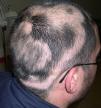Consultations for hair problems are very common in daily practice, with alopecia accounting for around 17.5% of all dermatologic consulations.1 Methods of examination in trichology can be classified into 3 categories: non-invasive (medical history, general examination, inspection and palpation of the hair and scalp, photographs, dermoscopy, etc.), semi-invasive (trichogram), and invasive (biopsy).2
In this article we discuss a case of occipital alopecia areata (AA) in which hair repopulation adopted a distinctive distribution.
The patient was a 33-year-old man with no past history of interest. For the previous 6 months he had been followed up in dermatology for what we considered to be a single plaque of AA in the occipital region. Treatment with topical corticosteroids and minoxidil was prescribed in association with intralesional corticosteroids on 2 occasions.
At 1 of the follow-up appointments, examination revealed annular areas of growth of black hair at the vertex and in the occipital region (Fig. 1A), and the initial plaque of alopecia had extended to the parietal region (Fig. 1B). The concentric areas of alopecia and hair repopulation produced a targetoid pattern (Fig. 2). Dermoscopy revealed numerous yellow and black dots and isolated fragmented hairs. A diagnosis of concentric or targetoid regrowth in AA was made and complete hair regrowth was achieved after a cycle of oral corticosteroids.
Cases of Köbner phenomenon have been described in AA, and other unusual forms of presentation, such as canities subita (Thomas More and Marie Antoinette syndromes), sisaipho, androgenetic alopecia, diffuse atypical forms, and transient rectangular alopecia.3,4
When hair regrowth occurs in AA, it is initially not uncommon to observe fine white hair or changes in hair texture (the hair may become straight or curly). Four paradoxical forms of hair regrowth exist: the castling phenomenon in which, after immunotherapy treatment with diphencyprone or squaric acid dibutylester, hair regrowth occurs in areas distinct from the site of application; the Renbök phenomenon, from the name Köbner written backwards, in which hair starts to grow on plaques of psoriasis or persists on congenital hairy nevi; perinevoid alopecia, characterized by hair loss around melanocytic nevi3,4; and targetoid or concentric regrowth, in which hair regrowth occurs in concentric rings at the vertex and in the occipital or parietal regions after treatment with topical immunotherapy, topical or intralesional corticosteroids, or even without previous therapy.5–7 Dr Emilio del Río, one of the first to describe this phenomenon, considered that this finding is not as rare as the few published cases might suggest.8 A number of hypotheses have been proposed to explain the phenomenon, including centrifugal accumulation of the corticosteroids because of application using the fingers,5 a minimal aggression that produces AA with dystrophic hair that rapidly enters normal anagen,3 or the normal clinical course of AA,9 which, like an earthquake, starts at the center and spreads peripherally in waves6 (spreading waves of anagen hair growth that reach refractory hair follicles in telogen giving rise to the typical concentric appearance).10
Although diagnosis is usually simple based on patient age, disease duration, and the medical history, the hair distribution can simulate other disorders that can present plaques of alopecia with an annular morphology or artifactual appearance. Trichotemnomania, a variant of trichotillomania in which sharp tools (scissors or razors) are used to cut the hair, has characteristic dermoscopic features such as the “V” sign, hair powder, and broken, spiral, flame, and tulip hairs, which help in its differentiation from AA. Lupus panniculitis can adopt an annular distribution following the Blaschko lines of the scalp. Traction alopecia, also called marginal alopecia because it typically affects the frontal, temporal, and occipital hairlines, is a condition produced by prolonged or repetitive tension on the scalp due to hairstyles in which the hair is placed under tension; a typical finding in this condition is the border sign, which consists of the preservation of hairs along the original line of hair implantation, giving it an annular appearance. Finally, transitory neonatal hair loss in the occipital region can also present an annular morphology.
In conclusion, we have presented a new case of concentric or targetoid hair growth, a possibly underdiagnosed form of paradoxical hair regrowth in AA that needs to be recognized to avoid confusion with other types of alopecia.
Conflicts of InterestThe authors declare that they have no conflicts of interest.
Please cite this article as: Monteagudo B, Suárez-Magdalena O, González-Vilas D, Suárez-Amor Ó. Crecimiento concéntrico en la alopecia areata (patrón en diana). Actas Dermosifiliogr. 2016;107:348–350.








